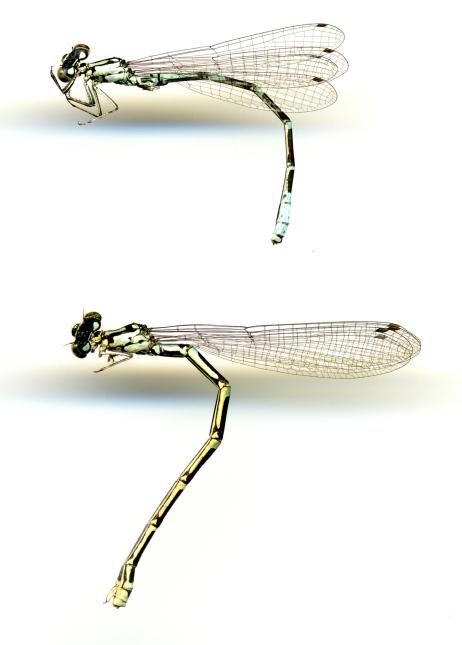Moderate-
High
The population of subarctic bluet is low, and its population trend is unknown. The subarctic bluet is restricted to boreal fens and bogs in the northeastern corner of the state. Only two populations of this species have been located in Washington.
Description and Range
Physical description
The subarctic bluet is a damselfly in the pond damsel family (Coenagrionidae).
Subarctic bluet adults are 1.1 to 1.3 inches long, with a hindwing measurement of .6 to .8 inches. Males and females are dimorphic. Paulson 2009 describes males as having black over blue eyes and a blue body with extensive black markings. There is a conspicuous black stripe on the side of the thorax, and a blue abdomen with a black "U" on segment 2. Subsequent segments show increasing amounts of black. Females may be blue like the male, or green. Eyes are brown over pale green. Thoracic strips are similar to the male.
Ecology and life history
This species depends on boreal bogs and fens, rare habitat types that are restricted to the northeast corner of the state. Within these rare wetlands, Subarctic bluets use dense sedge and moss mats, and adults also use the shrub ecotone. These habitats are sensitive to disturbance and many activities that impact local hydrology.
Adults have been detected at Washington sites in July.
The adult period for this species may be relatively short. Adults mate in dense vegetation; females lay eggs in small slits they cut in aquatic plants and have been observed egg-laying in floating sedge and grass leaves and stems, and emergent grass stems. Eggs develop quickly, and the resulting larvae are aquatic and feed on other aquatic invertebrates. This species overwinters in the larval stage.
Adults are also predators that specialize on flying insects.
Geographic range
The subarctic bluet is a boreal species, and ranges east across most of Canada into Maine, and into the western United States in northern Washington and Montana.
The species is known from only two sites in Washington, in Ferry and Pend Oreille Counties, between 4500 to 5000 feet in elevation. It may occur in additional boreal bogs and fens in this region. There is no information on population size from either Washington locality.
For the conservation status of this species, check out NatureServe Explorer.
Climate vulnerability
Sensitivity to climate change
High
The subarctic bluet is likely sensitive to drought, increasingly dry conditions (e.g., reduced snowpack, shifts from snow to rain), and altered hydrology (e.g., reduced flows and larger floods) that can lead to drying, habitat contraction and/or altered water quality in its fen and bog habitat. Subarctic bluet larvae are aquatic and depend on aquatic vegetation for foraging, making them sensitive to climate-driven habitat drying that may facilitate shifts toward more xeric vegetation. There are only a few populations of this species in Washington, representing the southern end of this species' range, so any significant alteration in bog habitat as a result of climate change could lead to loss of this species in the state. Similar to other odonates, subarctic bluet is likely also sensitive to increasing temperatures (air and water) in a variety of ways. Warmer temperatures may affect development, phenology, behavior, and other characteristics of this species.
Exposure to climate change
Moderate
- Altered flow regimes
- Drought
- Increased air and water temperatures
- Reduced snowpack and/or changes in precipitation
Conservation
Conservation Threats and Actions Needed
- Agriculture and aquaculture side effects
- Threat: Bon/fen obligate; habitat and species are vulnerable to alteration of local hydrology from logging and road building
- Action Needed: Identify bog/fen sites and landowners within species range and develop plans to conserve these areas
- Resource information collection needs
- Threat: Lack of data on current status and distribution
- Action Needed: Determining distribution and population status
See the Climate vulnerability section for information about the threats posed to this species by climate change
Resources
References
Paulson, D. 2014. Washington Odonata. Slater Museum of Natural History, University of Puget Sound, Tacoma, Washington. Available at: http://www.pugetsound.edu/academics/academic-resources/slater[1]museum/biodiversity-resources/dragonflies/washington-odonata/ [old link] (Accessed 8 October 2014).
Paulson, D. 2009. Dragonflies and Damselflies of the West. Princeton Univ. Press, Princeton, NJ. 535 pp.
US Forest Service and Bureau of Land Management (USFS-BLM). 2011. Species fact sheet: Subarctic Bluet. Prepared by The Xerces Society for Invertebrate Conservation. Portland, Oregon.
